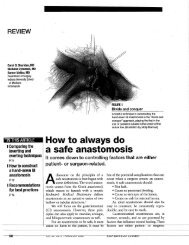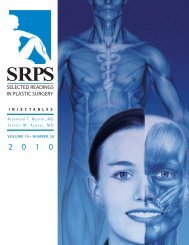SRPS PS - Plastic Surgery Internal
SRPS PS - Plastic Surgery Internal
SRPS PS - Plastic Surgery Internal
Create successful ePaper yourself
Turn your PDF publications into a flip-book with our unique Google optimized e-Paper software.
<strong>SR<strong>PS</strong></strong> Volume 10, Issue 25, 2009<br />
In the event that the thumb or little finger is<br />
involved with tenosynovitis, the infection can extend<br />
proximally to involve either the ulnar or radial bursa.<br />
The two bursae communicate through the space of<br />
Parona, deep to the flexor tendons in the distal<br />
forearm. A “horseshoe” abscess can form where a<br />
flexor tenosynovitis, beginning in either the thumb or<br />
little finger flexor sheath, spreads proximally to the<br />
space of Parona and then passes distally down either<br />
the little finger or thumb flexor tendon sheath. Phillips<br />
et al., 77 however, showed that the little finger flexor<br />
synovial sheath often ends at the level of the A1 pulley,<br />
so that little finger tenosynovitis usually can be<br />
managed by drainage of the finger alone. In instances<br />
in which an infection extends proximally, closed<br />
catheter drainage is indicated. The catheter is directed<br />
proximally from the incision at the level of the A1<br />
pulley. A counter incision is then made just proximal to<br />
the transverse wrist crease, where a drain is placed in<br />
the bursa. This system is managed in a similar fashion<br />
to the digital system. Again, if the patient does not<br />
respond to this treatment, open drainage of the bursae<br />
is necessary.<br />
Deep Space Infection<br />
A variety of “spaces” have been described in the hand.<br />
In reality, the spaces are potential and become<br />
significant only when infected, as they become<br />
loculations of purulent material. They include the<br />
thenar space, the midpalmar space, the subtendinous<br />
space, also known by the eponym Parona space, the<br />
hypothenar space, the dorsal subcutaneous space, the<br />
dorsal subaponeurotic space, and the interdigital web<br />
spaces. 78 The spaces often are confused with the<br />
compartments of the hand, which are the four dorsal<br />
interossei, three volar interossei, thenar, hypothenar,<br />
and adductor pollicis compartments.<br />
Infection in the spaces begins most frequently with<br />
a penetrating injury, the most commonly identified<br />
isolate being S. aureus. An antistaphylococcal agent can<br />
be used for initial antibiotic therapy unless gram stain<br />
at the time of drainage suggests another organism. As<br />
clearly described in the pre-antibiotic era by Kanavel, 69<br />
the key to treatment of deep space infections is precise<br />
drainage of the abscess, guided by knowledge and<br />
respect for the surrounding and involved structures.<br />
8<br />
The most important deep spaces of the hand are<br />
the midpalmar space and the thenar space (Fig. 8). 21<br />
Thenar space infections usually are characterized by<br />
the thumb being held in an abducted position, with<br />
pain over the adductor muscles and pain on extension<br />
or attempted opposition of the thumb. Thenar space<br />
infection is the only hand infection with which the<br />
thumb is not adducted. Drainage of the abscesses must<br />
not only respect the proximity of neurovascular<br />
structures, primarily the radial bundle to the index<br />
finger and the ulnar bundle to the thumb, but also<br />
must prevent scarring across the thumb-index web.<br />
Figure 8. Deep spaces of the hand. (Reprinted with permission<br />
from Brown and Young. 21 )<br />
The midpalmar space, exclusive of the flexor<br />
tendon sheaths, allows free spread of infection along<br />
fascial planes to deeper areas in the hand. Treatment<br />
consists of incision and drainage with catheter<br />
irrigation for 2 to 3 days. 78<br />
Osteomyelitis<br />
Osteomyelitis of the bony structures of the hand is a<br />
relatively infrequent infection. 79 Osteomyelitis can<br />
present as a spontaneous bone infection, usually by<br />
hematogenous seeding from a distant source. The most<br />
likely pathogens are Staphylococcus and Streptococcus<br />
species and, in young children, Haemophilus species.<br />
Osteomyelitis presents as a localized focus of<br />
erythema, pain, and swelling along the course of one<br />
of the long bones of the hand. If the infection does not<br />
show clinical signs of improvement within 48 hours of<br />
commencing intravenously administered antibiotic<br />
treatment, bone biopsy should be performed to obtain






